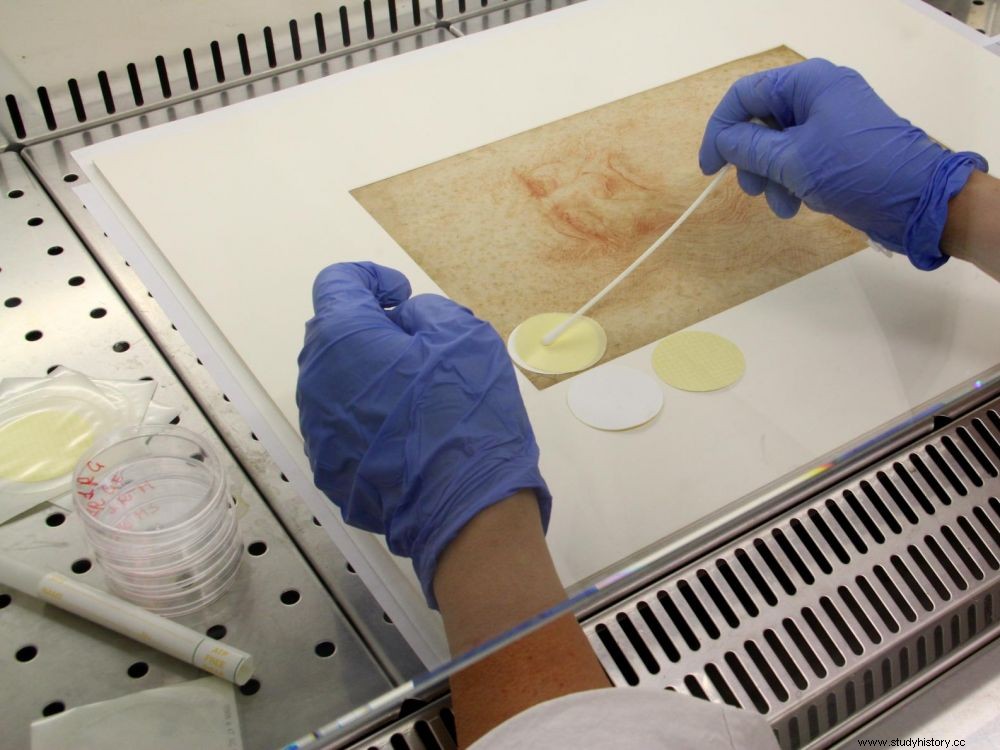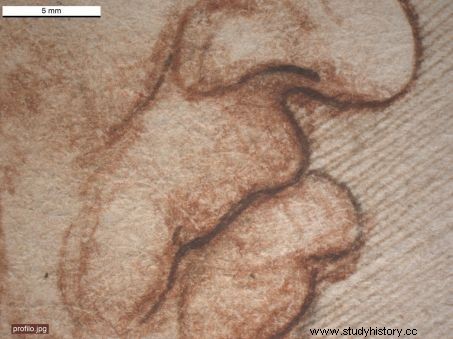The microbial composition of the artist's drawings carries information about the places where they were made and their journeys over the centuries.

Samples from one of Leonardo da Vinci's drawings.
"No one drew and wrote like Leonardo da Vinc i", testified Martin Kemp, art historian at the University of Oxford, in an article that Sciences et Avenir had devoted to Leonardo da Vinci in 2019, on the occasion of the 500th anniversary of his death. He drew everywhere and all the time and many of his drawings, sketches and sketches have come down to us. They reveal the techniques of the artist but they also carry, at the microscopic level, a lot of information about the geographical areas where they passed through as well as about the hands of the restorers through whom they passed.
Seven iconic designs
It was Austrian and Italian scientists who studied seven "emblematic" drawings by Leonardo da Vinci to extract the DNA residues they contain. To do this, they used a recent genomic approach called nanopore sequencing, which makes it possible to quickly obtain the order in which the nucleotides are linked together on a DNA fragment. Their findings, published in the journal Frontiers in Microbiology , lead to some surprises. The biggest being that they noted a dominance of bacteria over fungi, whereas until now it was accepted that the latter constituted the main community in the old papers. Moreover, it is they that are sought in a process of preservation of ancient manuscripts because of their potential for biodeterioration. But the bacterial predominance is perhaps one of the consequences of Leonardo's fame. Indeed, a high proportion of the bacteria identified are typical of the human microbiome, suggesting that these drawings have undergone intensive handling, during restoration work, and have passed through many hands. Including, of course, those of the Maestro. Moreover, the researchers have also found many human DNA but impossible to say that, among them, there is a trace of Leonardo's genetic material.
The other bacterial residues correspond to the microbiomes of insects, flies in particular, of which residues of excrement have also been identified and they could have been introduced from the time of the creation of the works. Each drawing seems to have its own identity with unique proportions in different bacteria and fungi. None of them, however, bear specific signs of wear (apart from the foxing of the design) even though they were handled visibly without gloves by restorers of the past, as evidenced by the numerous human DNA.
"No one drew and wrote like Leonardo da Vinc i", testified Martin Kemp, art historian at the University of Oxford, in an article that Sciences et Avenir had devoted to Leonardo da Vinci in 2019, on the occasion of the 500th anniversary of his death. He drew everywhere and all the time and many of his drawings, sketches and sketches have come down to us. They reveal the techniques of the artist but they also carry, at the microscopic level, a lot of information about the geographical areas where they passed through as well as about the hands of the restorers through whom they passed.
Seven iconic designs
It was Austrian and Italian scientists who studied seven "emblematic" drawings by Leonardo da Vinci to extract the DNA residues they contain. To do this, they used a recent genomic approach called nanopore sequencing, which makes it possible to quickly obtain the order in which the nucleotides are linked together on a DNA fragment. Their findings, published in the journal Frontiers in Microbiology , lead to some surprises. The biggest being that they noted a dominance of bacteria over fungi, whereas until now it was accepted that the latter constituted the main community in the old papers. Moreover, it is they that are sought in a process of preservation of ancient manuscripts because of their potential for biodeterioration. But the bacterial predominance is perhaps one of the consequences of Leonardo's fame. Indeed, a high proportion of the bacteria identified are typical of the human microbiome, suggesting that these drawings have undergone intensive handling, during restoration work, and have passed through many hands. Including, of course, those of the Maestro. Moreover, the researchers have also found many human DNA but impossible to say that, among them, there is a trace of Leonardo's genetic material.
The other bacterial residues correspond to the microbiomes of insects, flies in particular, of which residues of excrement have also been identified and they could have been introduced from the time of the creation of the works. Each drawing seems to have its own identity with unique proportions in different bacteria and fungi. None of them, however, bear specific signs of wear (apart from the foxing of the design) even though they were handled visibly without gloves by restorers of the past, as evidenced by the numerous human DNA.

One of the drawings studied. Credit:Leonardo da Vinci/Frontiers in Microbiology .
Towards bio-archives of works of art
The researchers also spotted taxa that may reveal where some of these drawings were stored in the past. Thus, some carried the signature of bacteria discovered only in drawings kept at the Royal Library in Turin, while other taxa were only detected in drawings kept at the Corsican Library in Rome. In the end, it seems that the geographic location, the insects that landed on the drawings, and the humans that handled them all left traces, invisible to the eye but well detectable with our current techniques. It is not entirely a surprise since the same team had, in 2019, been able to identify the storage conditions and even the geographical route of three marble statues and that this year, it is a 1,000-year-old parchment that has spoken:the study of its microbiome has made it possible to trace the animal origin of the skins with which it was made.
For the authors of the study, the microbiome of drawings and more generally of works of art could make it possible to constitute "bio-archives" of their history. "Thus, scientists could develop new methods to not only preserve the visual appearance of art, but also to document the unseen journey of our artistic and cultural heritage " they conclude.
